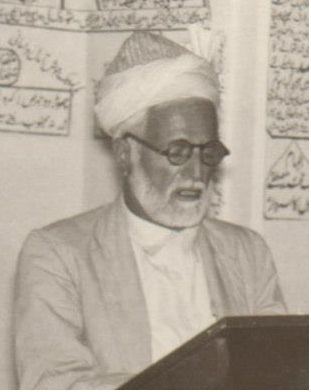Name Shams Din | ||
 | ||
Shams ud Din Khan (1900–1969) has been a notable early Pashtun Ahmadi in the North West Frontier province of India. (Now Khyber Pakhtunkhwa Pakistan) He remained its Provincial Ameer [Head] (1969). He was a close associate of Khalifatul Masih II and III.( Mirza Basheer-ud-Din Mahmood Ahmad and Mirza Nasir Ahmad) in his lifetime. He was a member of the Jama’at Khilafat Committee [Electoral College] and was one of the two proposers of the name of Mirza Nasir Ahmad at the time of his Election to the seat of Khilafat in November 1965. He remained a member of the Majlis Shura [Consultative Assembly] of the Ahmadiyya Muslim Community in Pakistan.
Contents
Early life
Shams ud Din Khan was born January 26, 1900, to Hafiz Haji Noor Muhammad (1835-1904). His father died when he was four. Noor Muhammad, has an important legacy associated with him in the history of Ahmadiyya Community. Something which ultimately led Shams ud Din Khan to convert to Ahmadiyya in 1927. He received his education from the Islamia Collegite High School at Peshawar.(1917) He married thrice, every time after the death of his wives. He had thirteen children, six sons and seven daughters.He was son in Law to Sahibzada Abdul Lateef, a cousin of Sahibzada Nawab Sir Sahibzada Abdul Qayyum (1863 – 1937) (Once Chief Minister North West Frontier Province (1937) and Founder of the Islamia College Peshawar) His wife Amatul Aziz Begum (1924-2016) had been Sadar (Head) the Women Wing Ahmadiyya Community, Lajna Imaillah North West Frontier Province.
Conversion
The family of Shams ud Din Khan had a unique historical link with the Ahmadiyya movement. His father Hafiz Haji Noor Muhammad, went to Qadian in 1901. He met the Founder of Ahmadiyya Community, Mirza Ghulam Ahmad. In fact Noor Muhammad had taken all this trouble, in his old age, and took the journey from Kotha Gari Amazai,District Swabi to Qadian to testify and see for himself the fulfillment of a vision of his own spiritual master Syed Ameer Sahib of Khota (1800-1879) Swabi.
This witness of Noor Muhammad, said to be a vision, of Syed Ameer sahib of Kotha (1800-1879), and has been recorded in his book ‘Tohfa e Golarviyya’ by Mirza Ghulam Ahmad (1902); Noor Muhammad narrated his master’s vision:
The vision has also been mentioned independently, by other sources, not associated with Ahmadiyya Community, Sahibzada Muhammad Ashraf (of the progeny of Syed Ameer sahib) in his biography of Syed Ameer sahib mentions the same experience of the Syed.
It is reported that Shams ud Din’s father did not accept Mirza Ghulam Ahmad, he was old and weak, and he could not go back to his home and died at Nainital India in 1904. This strong emotional legacy must have touched Shams ud Din. He read the book ‘Tohfa e Golarviyya’ in 1927, with all the transforming effects of his father being mentioned by Mirza Ghulam Ahmad, his journey to Qadian India and never returning home, leaving Shams ud Din an orphan at age four. He took Bay'ah at the hands of Khalifatul Masih II in 1927.
Death
Shams ud Din Khan took part in the Election of the Third Caliph of the Ahmadiyya Muslim Community after the demise of Hazrat Mirza Basheer-ud-Din Mahmood Ahmad on the 7 November 1965. He served as the Provincial Head of the Jamaat in Khyber Pakhtunkhwa till his death on the February 14, 1969. He was buried at Rabwah in the Bahishti Maqbara (English : The Heavenly Graveyard). Hazrat Mirza Nasir Ahmad Khalifatul Masih III offered his funeral prayers and personally participated in the funeral procession.
